HLTENN001: Nursing Practice within the Australian Health System
VerifiedAdded on 2023/06/14
|13
|4248
|474
Homework Assignment
AI Summary
This assignment provides a comprehensive overview of nursing practice within the Australian healthcare system (HLTENN001). It covers various key models of health, including the social and biomedical models, and discusses the application of the National Safety and Quality Health Service (NSQHS) Standards. The assignment also explores the structure of the healthcare system in Victoria, the evolution of the nursing profession in Australia, current perspectives in nursing, and opportunities for career development. Furthermore, it explains the philosophical framework underpinning primary health care, different models of care such as the holistic health model and the health-illness continuum, and the roles of nursing regulatory authorities like the Nursing and Midwifery Board of Australia and the Australian Health Practitioner Regulation Agency. The assignment also addresses population health issues faced by culturally and linguistically diverse backgrounds, the roles of organizations like Private Healthcare Australia and Centrelink in health insurance and financial support, health issues prevailing among Aboriginal and Torres Strait Islander people, examples of healthcare environments for enrolled nurses, the roles of interdisciplinary health care team members in rehabilitation, the impact of environmental and cultural factors on health, and the political impacts on healthcare delivery with reference to the National Health Priority Areas (NHPAs).
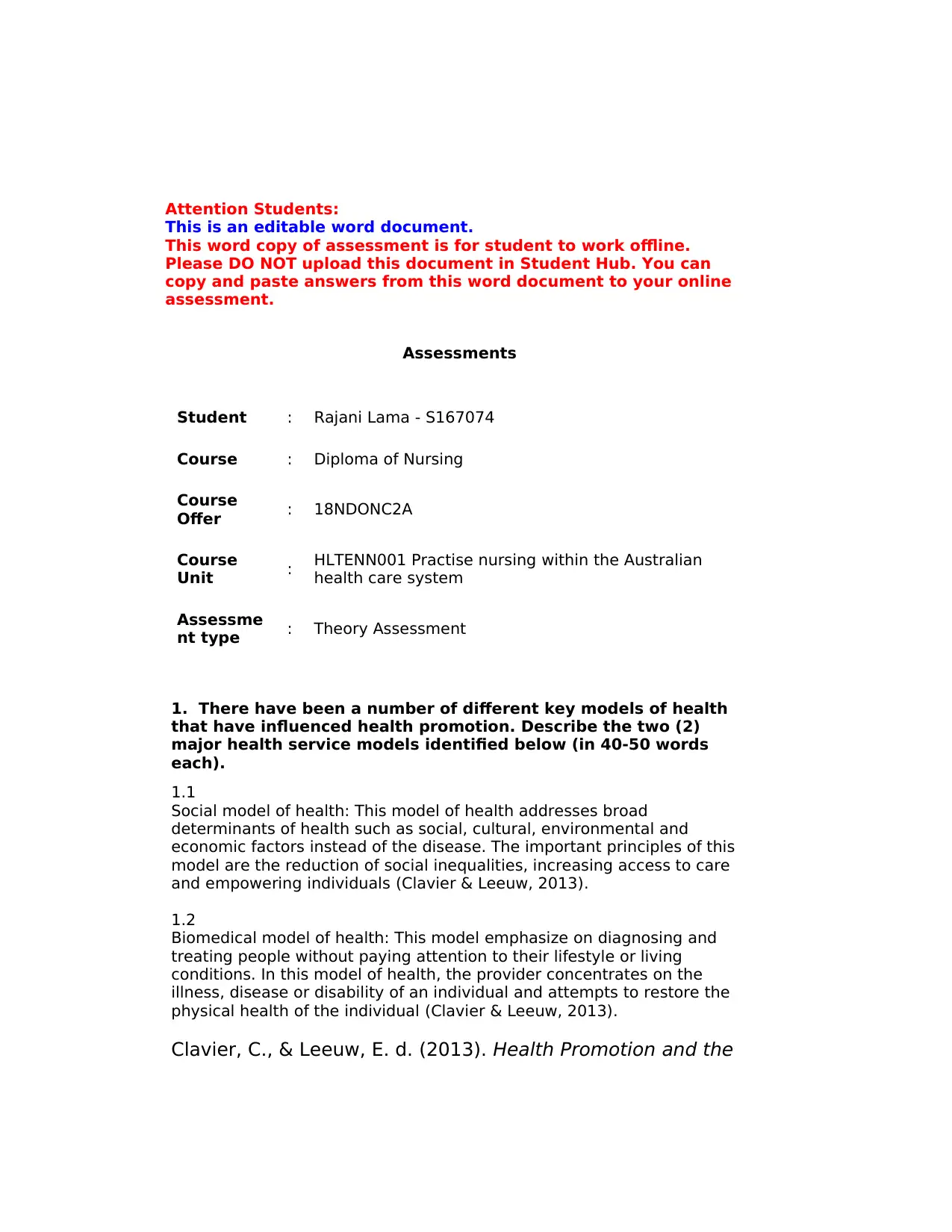
Attention Students:
This is an editable word document.
This word copy of assessment is for student to work offline.
Please DO NOT upload this document in Student Hub. You can
copy and paste answers from this word document to your online
assessment.
Assessments
Student : Rajani Lama - S167074
Course : Diploma of Nursing
Course
Offer : 18NDONC2A
Course
Unit : HLTENN001 Practise nursing within the Australian
health care system
Assessme
nt type : Theory Assessment
1. There have been a number of different key models of health
that have influenced health promotion. Describe the two (2)
major health service models identified below (in 40-50 words
each).
1.1
Social model of health: This model of health addresses broad
determinants of health such as social, cultural, environmental and
economic factors instead of the disease. The important principles of this
model are the reduction of social inequalities, increasing access to care
and empowering individuals (Clavier & Leeuw, 2013).
1.2
Biomedical model of health: This model emphasize on diagnosing and
treating people without paying attention to their lifestyle or living
conditions. In this model of health, the provider concentrates on the
illness, disease or disability of an individual and attempts to restore the
physical health of the individual (Clavier & Leeuw, 2013).
Clavier, C., & Leeuw, E. d. (2013). Health Promotion and the
This is an editable word document.
This word copy of assessment is for student to work offline.
Please DO NOT upload this document in Student Hub. You can
copy and paste answers from this word document to your online
assessment.
Assessments
Student : Rajani Lama - S167074
Course : Diploma of Nursing
Course
Offer : 18NDONC2A
Course
Unit : HLTENN001 Practise nursing within the Australian
health care system
Assessme
nt type : Theory Assessment
1. There have been a number of different key models of health
that have influenced health promotion. Describe the two (2)
major health service models identified below (in 40-50 words
each).
1.1
Social model of health: This model of health addresses broad
determinants of health such as social, cultural, environmental and
economic factors instead of the disease. The important principles of this
model are the reduction of social inequalities, increasing access to care
and empowering individuals (Clavier & Leeuw, 2013).
1.2
Biomedical model of health: This model emphasize on diagnosing and
treating people without paying attention to their lifestyle or living
conditions. In this model of health, the provider concentrates on the
illness, disease or disability of an individual and attempts to restore the
physical health of the individual (Clavier & Leeuw, 2013).
Clavier, C., & Leeuw, E. d. (2013). Health Promotion and the
Paraphrase This Document
Need a fresh take? Get an instant paraphrase of this document with our AI Paraphraser
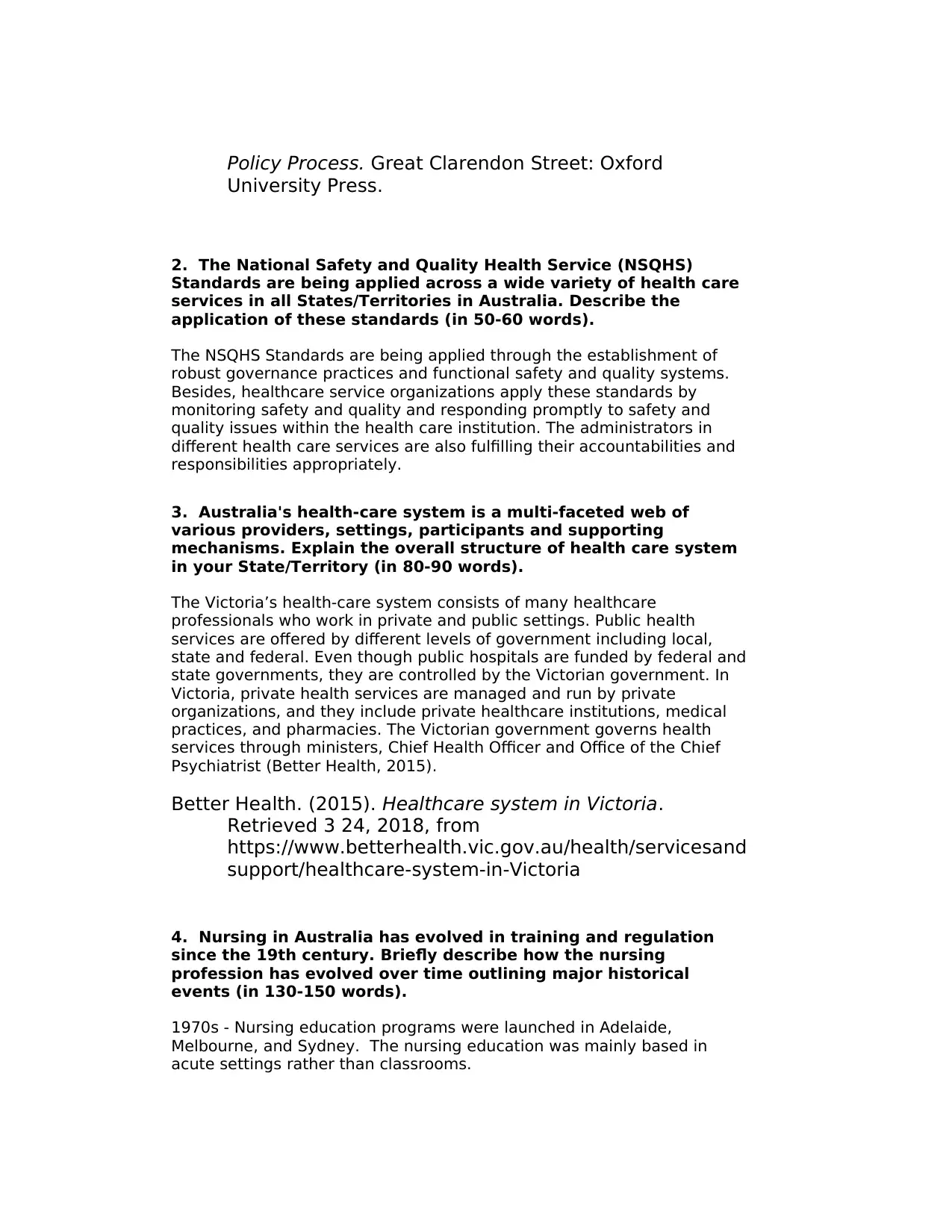
Policy Process. Great Clarendon Street: Oxford
University Press.
2. The National Safety and Quality Health Service (NSQHS)
Standards are being applied across a wide variety of health care
services in all States/Territories in Australia. Describe the
application of these standards (in 50-60 words).
The NSQHS Standards are being applied through the establishment of
robust governance practices and functional safety and quality systems.
Besides, healthcare service organizations apply these standards by
monitoring safety and quality and responding promptly to safety and
quality issues within the health care institution. The administrators in
different health care services are also fulfilling their accountabilities and
responsibilities appropriately.
3. Australia's health-care system is a multi-faceted web of
various providers, settings, participants and supporting
mechanisms. Explain the overall structure of health care system
in your State/Territory (in 80-90 words).
The Victoria’s health-care system consists of many healthcare
professionals who work in private and public settings. Public health
services are offered by different levels of government including local,
state and federal. Even though public hospitals are funded by federal and
state governments, they are controlled by the Victorian government. In
Victoria, private health services are managed and run by private
organizations, and they include private healthcare institutions, medical
practices, and pharmacies. The Victorian government governs health
services through ministers, Chief Health Officer and Office of the Chief
Psychiatrist (Better Health, 2015).
Better Health. (2015). Healthcare system in Victoria.
Retrieved 3 24, 2018, from
https://www.betterhealth.vic.gov.au/health/servicesand
support/healthcare-system-in-Victoria
4. Nursing in Australia has evolved in training and regulation
since the 19th century. Briefly describe how the nursing
profession has evolved over time outlining major historical
events (in 130-150 words).
1970s - Nursing education programs were launched in Adelaide,
Melbourne, and Sydney. The nursing education was mainly based in
acute settings rather than classrooms.
University Press.
2. The National Safety and Quality Health Service (NSQHS)
Standards are being applied across a wide variety of health care
services in all States/Territories in Australia. Describe the
application of these standards (in 50-60 words).
The NSQHS Standards are being applied through the establishment of
robust governance practices and functional safety and quality systems.
Besides, healthcare service organizations apply these standards by
monitoring safety and quality and responding promptly to safety and
quality issues within the health care institution. The administrators in
different health care services are also fulfilling their accountabilities and
responsibilities appropriately.
3. Australia's health-care system is a multi-faceted web of
various providers, settings, participants and supporting
mechanisms. Explain the overall structure of health care system
in your State/Territory (in 80-90 words).
The Victoria’s health-care system consists of many healthcare
professionals who work in private and public settings. Public health
services are offered by different levels of government including local,
state and federal. Even though public hospitals are funded by federal and
state governments, they are controlled by the Victorian government. In
Victoria, private health services are managed and run by private
organizations, and they include private healthcare institutions, medical
practices, and pharmacies. The Victorian government governs health
services through ministers, Chief Health Officer and Office of the Chief
Psychiatrist (Better Health, 2015).
Better Health. (2015). Healthcare system in Victoria.
Retrieved 3 24, 2018, from
https://www.betterhealth.vic.gov.au/health/servicesand
support/healthcare-system-in-Victoria
4. Nursing in Australia has evolved in training and regulation
since the 19th century. Briefly describe how the nursing
profession has evolved over time outlining major historical
events (in 130-150 words).
1970s - Nursing education programs were launched in Adelaide,
Melbourne, and Sydney. The nursing education was mainly based in
acute settings rather than classrooms.
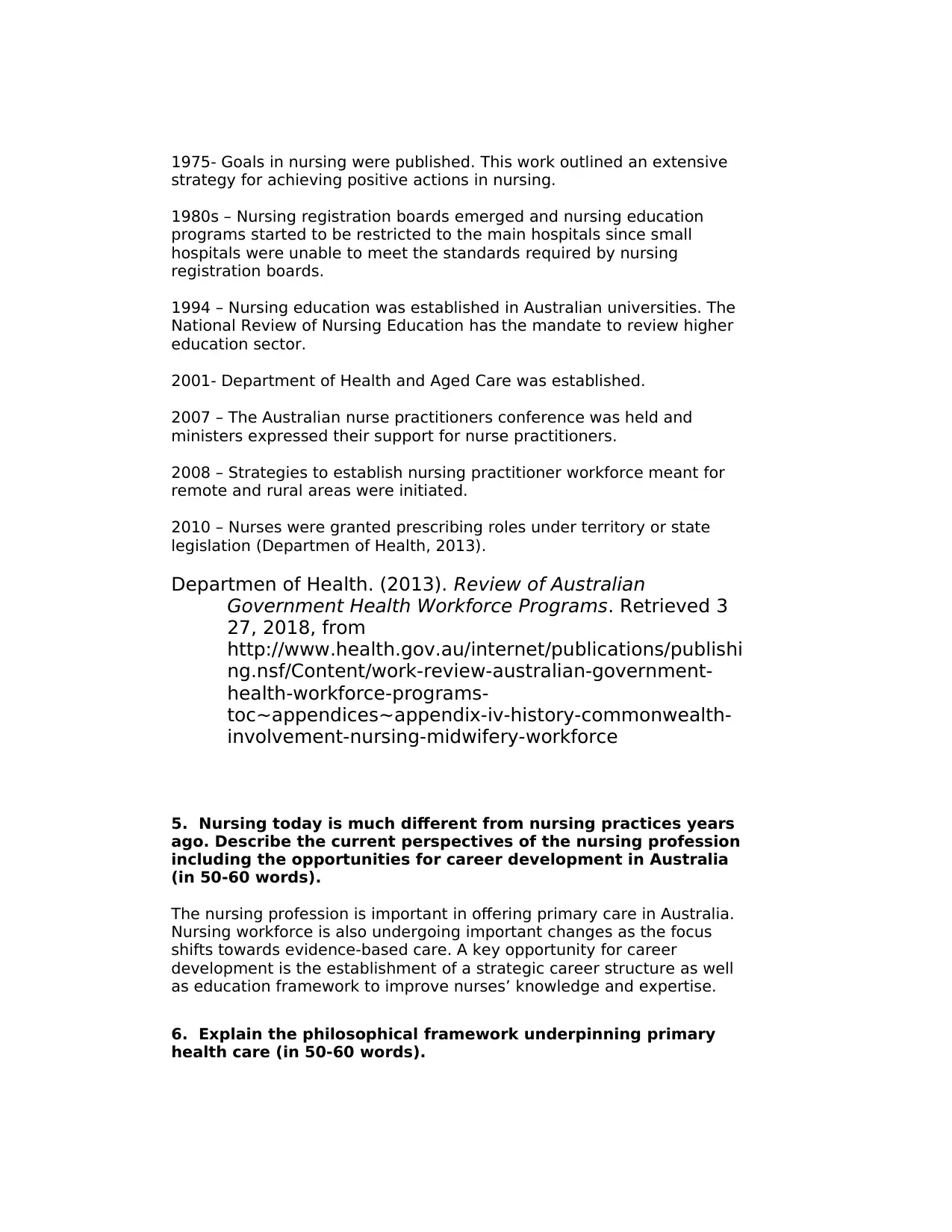
1975- Goals in nursing were published. This work outlined an extensive
strategy for achieving positive actions in nursing.
1980s – Nursing registration boards emerged and nursing education
programs started to be restricted to the main hospitals since small
hospitals were unable to meet the standards required by nursing
registration boards.
1994 – Nursing education was established in Australian universities. The
National Review of Nursing Education has the mandate to review higher
education sector.
2001- Department of Health and Aged Care was established.
2007 – The Australian nurse practitioners conference was held and
ministers expressed their support for nurse practitioners.
2008 – Strategies to establish nursing practitioner workforce meant for
remote and rural areas were initiated.
2010 – Nurses were granted prescribing roles under territory or state
legislation (Departmen of Health, 2013).
Departmen of Health. (2013). Review of Australian
Government Health Workforce Programs. Retrieved 3
27, 2018, from
http://www.health.gov.au/internet/publications/publishi
ng.nsf/Content/work-review-australian-government-
health-workforce-programs-
toc~appendices~appendix-iv-history-commonwealth-
involvement-nursing-midwifery-workforce
5. Nursing today is much different from nursing practices years
ago. Describe the current perspectives of the nursing profession
including the opportunities for career development in Australia
(in 50-60 words).
The nursing profession is important in offering primary care in Australia.
Nursing workforce is also undergoing important changes as the focus
shifts towards evidence-based care. A key opportunity for career
development is the establishment of a strategic career structure as well
as education framework to improve nurses’ knowledge and expertise.
6. Explain the philosophical framework underpinning primary
health care (in 50-60 words).
strategy for achieving positive actions in nursing.
1980s – Nursing registration boards emerged and nursing education
programs started to be restricted to the main hospitals since small
hospitals were unable to meet the standards required by nursing
registration boards.
1994 – Nursing education was established in Australian universities. The
National Review of Nursing Education has the mandate to review higher
education sector.
2001- Department of Health and Aged Care was established.
2007 – The Australian nurse practitioners conference was held and
ministers expressed their support for nurse practitioners.
2008 – Strategies to establish nursing practitioner workforce meant for
remote and rural areas were initiated.
2010 – Nurses were granted prescribing roles under territory or state
legislation (Departmen of Health, 2013).
Departmen of Health. (2013). Review of Australian
Government Health Workforce Programs. Retrieved 3
27, 2018, from
http://www.health.gov.au/internet/publications/publishi
ng.nsf/Content/work-review-australian-government-
health-workforce-programs-
toc~appendices~appendix-iv-history-commonwealth-
involvement-nursing-midwifery-workforce
5. Nursing today is much different from nursing practices years
ago. Describe the current perspectives of the nursing profession
including the opportunities for career development in Australia
(in 50-60 words).
The nursing profession is important in offering primary care in Australia.
Nursing workforce is also undergoing important changes as the focus
shifts towards evidence-based care. A key opportunity for career
development is the establishment of a strategic career structure as well
as education framework to improve nurses’ knowledge and expertise.
6. Explain the philosophical framework underpinning primary
health care (in 50-60 words).
⊘ This is a preview!⊘
Do you want full access?
Subscribe today to unlock all pages.

Trusted by 1+ million students worldwide
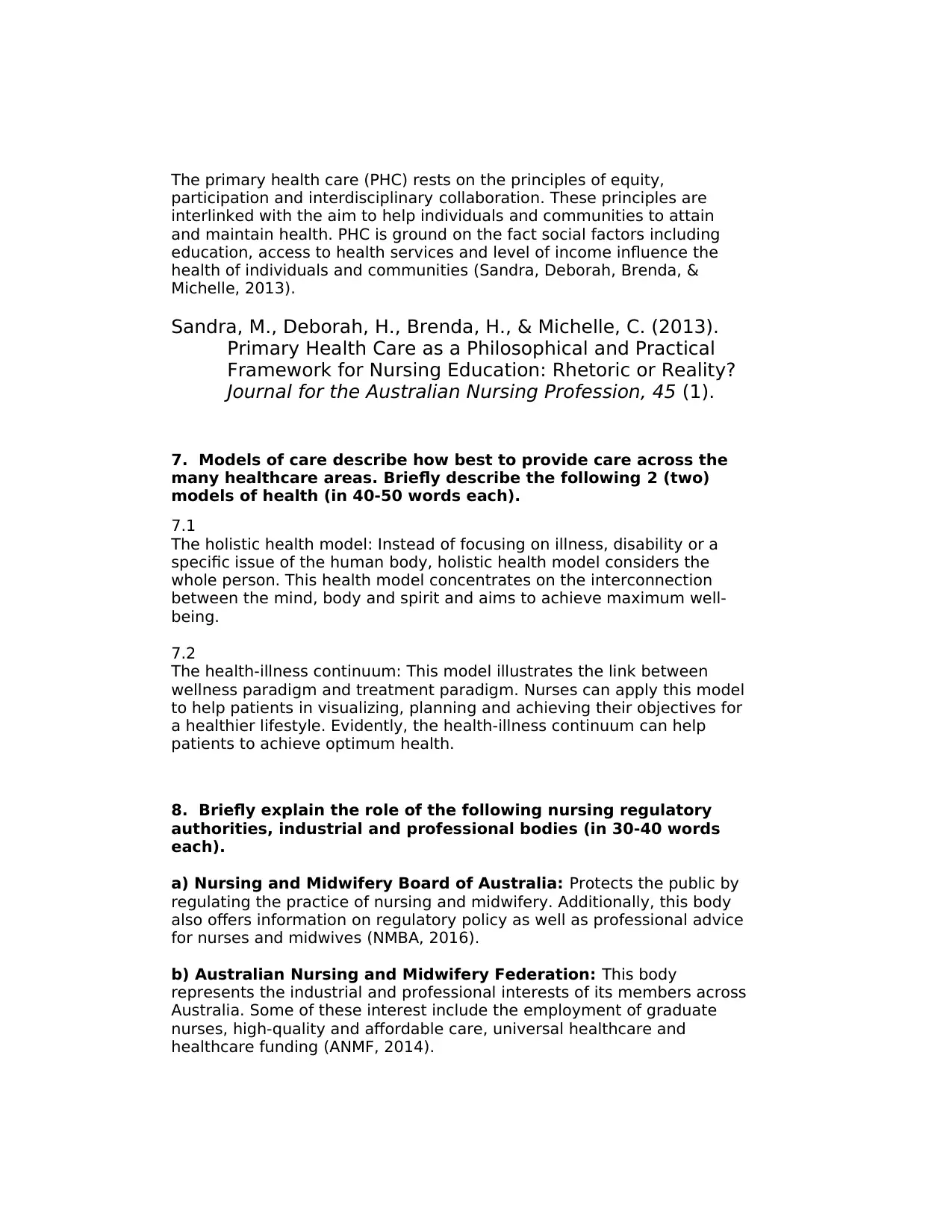
The primary health care (PHC) rests on the principles of equity,
participation and interdisciplinary collaboration. These principles are
interlinked with the aim to help individuals and communities to attain
and maintain health. PHC is ground on the fact social factors including
education, access to health services and level of income influence the
health of individuals and communities (Sandra, Deborah, Brenda, &
Michelle, 2013).
Sandra, M., Deborah, H., Brenda, H., & Michelle, C. (2013).
Primary Health Care as a Philosophical and Practical
Framework for Nursing Education: Rhetoric or Reality?
Journal for the Australian Nursing Profession, 45 (1).
7. Models of care describe how best to provide care across the
many healthcare areas. Briefly describe the following 2 (two)
models of health (in 40-50 words each).
7.1
The holistic health model: Instead of focusing on illness, disability or a
specific issue of the human body, holistic health model considers the
whole person. This health model concentrates on the interconnection
between the mind, body and spirit and aims to achieve maximum well-
being.
7.2
The health-illness continuum: This model illustrates the link between
wellness paradigm and treatment paradigm. Nurses can apply this model
to help patients in visualizing, planning and achieving their objectives for
a healthier lifestyle. Evidently, the health-illness continuum can help
patients to achieve optimum health.
8. Briefly explain the role of the following nursing regulatory
authorities, industrial and professional bodies (in 30-40 words
each).
a) Nursing and Midwifery Board of Australia: Protects the public by
regulating the practice of nursing and midwifery. Additionally, this body
also offers information on regulatory policy as well as professional advice
for nurses and midwives (NMBA, 2016).
b) Australian Nursing and Midwifery Federation: This body
represents the industrial and professional interests of its members across
Australia. Some of these interest include the employment of graduate
nurses, high-quality and affordable care, universal healthcare and
healthcare funding (ANMF, 2014).
participation and interdisciplinary collaboration. These principles are
interlinked with the aim to help individuals and communities to attain
and maintain health. PHC is ground on the fact social factors including
education, access to health services and level of income influence the
health of individuals and communities (Sandra, Deborah, Brenda, &
Michelle, 2013).
Sandra, M., Deborah, H., Brenda, H., & Michelle, C. (2013).
Primary Health Care as a Philosophical and Practical
Framework for Nursing Education: Rhetoric or Reality?
Journal for the Australian Nursing Profession, 45 (1).
7. Models of care describe how best to provide care across the
many healthcare areas. Briefly describe the following 2 (two)
models of health (in 40-50 words each).
7.1
The holistic health model: Instead of focusing on illness, disability or a
specific issue of the human body, holistic health model considers the
whole person. This health model concentrates on the interconnection
between the mind, body and spirit and aims to achieve maximum well-
being.
7.2
The health-illness continuum: This model illustrates the link between
wellness paradigm and treatment paradigm. Nurses can apply this model
to help patients in visualizing, planning and achieving their objectives for
a healthier lifestyle. Evidently, the health-illness continuum can help
patients to achieve optimum health.
8. Briefly explain the role of the following nursing regulatory
authorities, industrial and professional bodies (in 30-40 words
each).
a) Nursing and Midwifery Board of Australia: Protects the public by
regulating the practice of nursing and midwifery. Additionally, this body
also offers information on regulatory policy as well as professional advice
for nurses and midwives (NMBA, 2016).
b) Australian Nursing and Midwifery Federation: This body
represents the industrial and professional interests of its members across
Australia. Some of these interest include the employment of graduate
nurses, high-quality and affordable care, universal healthcare and
healthcare funding (ANMF, 2014).
Paraphrase This Document
Need a fresh take? Get an instant paraphrase of this document with our AI Paraphraser
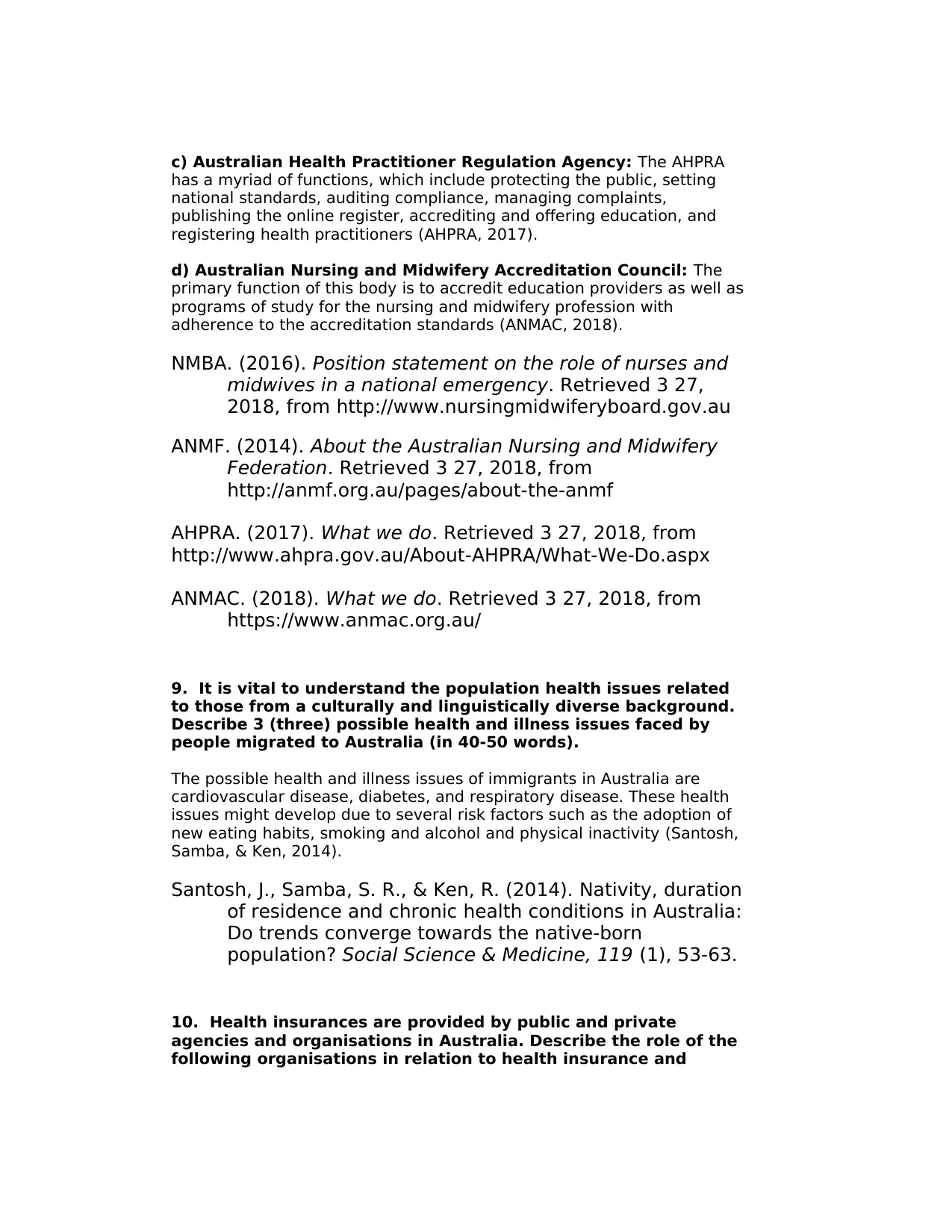
c) Australian Health Practitioner Regulation Agency: The AHPRA
has a myriad of functions, which include protecting the public, setting
national standards, auditing compliance, managing complaints,
publishing the online register, accrediting and offering education, and
registering health practitioners (AHPRA, 2017).
d) Australian Nursing and Midwifery Accreditation Council: The
primary function of this body is to accredit education providers as well as
programs of study for the nursing and midwifery profession with
adherence to the accreditation standards (ANMAC, 2018).
NMBA. (2016). Position statement on the role of nurses and
midwives in a national emergency. Retrieved 3 27,
2018, from http://www.nursingmidwiferyboard.gov.au
ANMF. (2014). About the Australian Nursing and Midwifery
Federation. Retrieved 3 27, 2018, from
http://anmf.org.au/pages/about-the-anmf
AHPRA. (2017). What we do. Retrieved 3 27, 2018, from
http://www.ahpra.gov.au/About-AHPRA/What-We-Do.aspx
ANMAC. (2018). What we do. Retrieved 3 27, 2018, from
https://www.anmac.org.au/
9. It is vital to understand the population health issues related
to those from a culturally and linguistically diverse background.
Describe 3 (three) possible health and illness issues faced by
people migrated to Australia (in 40-50 words).
The possible health and illness issues of immigrants in Australia are
cardiovascular disease, diabetes, and respiratory disease. These health
issues might develop due to several risk factors such as the adoption of
new eating habits, smoking and alcohol and physical inactivity (Santosh,
Samba, & Ken, 2014).
Santosh, J., Samba, S. R., & Ken, R. (2014). Nativity, duration
of residence and chronic health conditions in Australia:
Do trends converge towards the native-born
population? Social Science & Medicine, 119 (1), 53-63.
10. Health insurances are provided by public and private
agencies and organisations in Australia. Describe the role of the
following organisations in relation to health insurance and
has a myriad of functions, which include protecting the public, setting
national standards, auditing compliance, managing complaints,
publishing the online register, accrediting and offering education, and
registering health practitioners (AHPRA, 2017).
d) Australian Nursing and Midwifery Accreditation Council: The
primary function of this body is to accredit education providers as well as
programs of study for the nursing and midwifery profession with
adherence to the accreditation standards (ANMAC, 2018).
NMBA. (2016). Position statement on the role of nurses and
midwives in a national emergency. Retrieved 3 27,
2018, from http://www.nursingmidwiferyboard.gov.au
ANMF. (2014). About the Australian Nursing and Midwifery
Federation. Retrieved 3 27, 2018, from
http://anmf.org.au/pages/about-the-anmf
AHPRA. (2017). What we do. Retrieved 3 27, 2018, from
http://www.ahpra.gov.au/About-AHPRA/What-We-Do.aspx
ANMAC. (2018). What we do. Retrieved 3 27, 2018, from
https://www.anmac.org.au/
9. It is vital to understand the population health issues related
to those from a culturally and linguistically diverse background.
Describe 3 (three) possible health and illness issues faced by
people migrated to Australia (in 40-50 words).
The possible health and illness issues of immigrants in Australia are
cardiovascular disease, diabetes, and respiratory disease. These health
issues might develop due to several risk factors such as the adoption of
new eating habits, smoking and alcohol and physical inactivity (Santosh,
Samba, & Ken, 2014).
Santosh, J., Samba, S. R., & Ken, R. (2014). Nativity, duration
of residence and chronic health conditions in Australia:
Do trends converge towards the native-born
population? Social Science & Medicine, 119 (1), 53-63.
10. Health insurances are provided by public and private
agencies and organisations in Australia. Describe the role of the
following organisations in relation to health insurance and
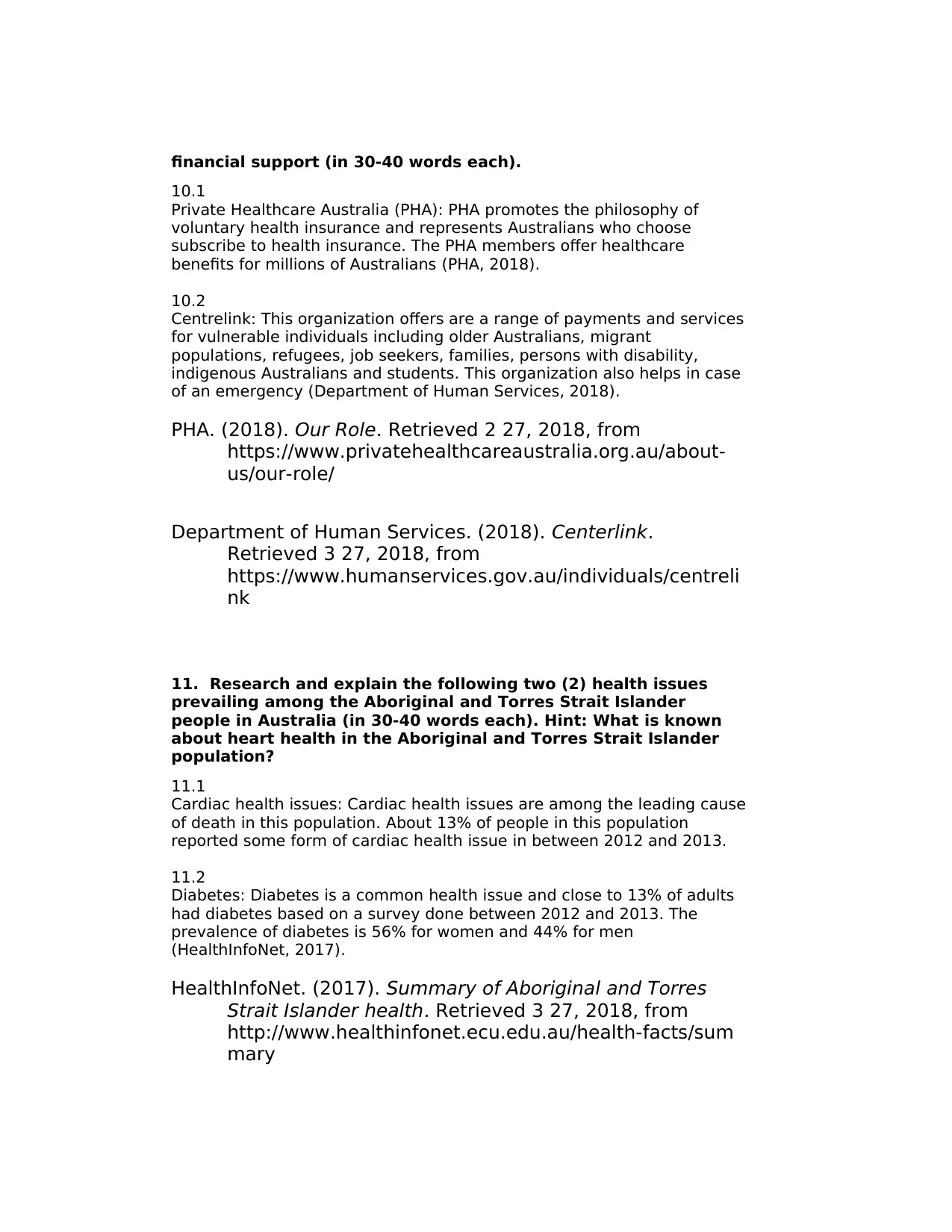
financial support (in 30-40 words each).
10.1
Private Healthcare Australia (PHA): PHA promotes the philosophy of
voluntary health insurance and represents Australians who choose
subscribe to health insurance. The PHA members offer healthcare
benefits for millions of Australians (PHA, 2018).
10.2
Centrelink: This organization offers are a range of payments and services
for vulnerable individuals including older Australians, migrant
populations, refugees, job seekers, families, persons with disability,
indigenous Australians and students. This organization also helps in case
of an emergency (Department of Human Services, 2018).
PHA. (2018). Our Role. Retrieved 2 27, 2018, from
https://www.privatehealthcareaustralia.org.au/about-
us/our-role/
Department of Human Services. (2018). Centerlink.
Retrieved 3 27, 2018, from
https://www.humanservices.gov.au/individuals/centreli
nk
11. Research and explain the following two (2) health issues
prevailing among the Aboriginal and Torres Strait Islander
people in Australia (in 30-40 words each). Hint: What is known
about heart health in the Aboriginal and Torres Strait Islander
population?
11.1
Cardiac health issues: Cardiac health issues are among the leading cause
of death in this population. About 13% of people in this population
reported some form of cardiac health issue in between 2012 and 2013.
11.2
Diabetes: Diabetes is a common health issue and close to 13% of adults
had diabetes based on a survey done between 2012 and 2013. The
prevalence of diabetes is 56% for women and 44% for men
(HealthInfoNet, 2017).
HealthInfoNet. (2017). Summary of Aboriginal and Torres
Strait Islander health. Retrieved 3 27, 2018, from
http://www.healthinfonet.ecu.edu.au/health-facts/sum
mary
10.1
Private Healthcare Australia (PHA): PHA promotes the philosophy of
voluntary health insurance and represents Australians who choose
subscribe to health insurance. The PHA members offer healthcare
benefits for millions of Australians (PHA, 2018).
10.2
Centrelink: This organization offers are a range of payments and services
for vulnerable individuals including older Australians, migrant
populations, refugees, job seekers, families, persons with disability,
indigenous Australians and students. This organization also helps in case
of an emergency (Department of Human Services, 2018).
PHA. (2018). Our Role. Retrieved 2 27, 2018, from
https://www.privatehealthcareaustralia.org.au/about-
us/our-role/
Department of Human Services. (2018). Centerlink.
Retrieved 3 27, 2018, from
https://www.humanservices.gov.au/individuals/centreli
nk
11. Research and explain the following two (2) health issues
prevailing among the Aboriginal and Torres Strait Islander
people in Australia (in 30-40 words each). Hint: What is known
about heart health in the Aboriginal and Torres Strait Islander
population?
11.1
Cardiac health issues: Cardiac health issues are among the leading cause
of death in this population. About 13% of people in this population
reported some form of cardiac health issue in between 2012 and 2013.
11.2
Diabetes: Diabetes is a common health issue and close to 13% of adults
had diabetes based on a survey done between 2012 and 2013. The
prevalence of diabetes is 56% for women and 44% for men
(HealthInfoNet, 2017).
HealthInfoNet. (2017). Summary of Aboriginal and Torres
Strait Islander health. Retrieved 3 27, 2018, from
http://www.healthinfonet.ecu.edu.au/health-facts/sum
mary
⊘ This is a preview!⊘
Do you want full access?
Subscribe today to unlock all pages.

Trusted by 1+ million students worldwide
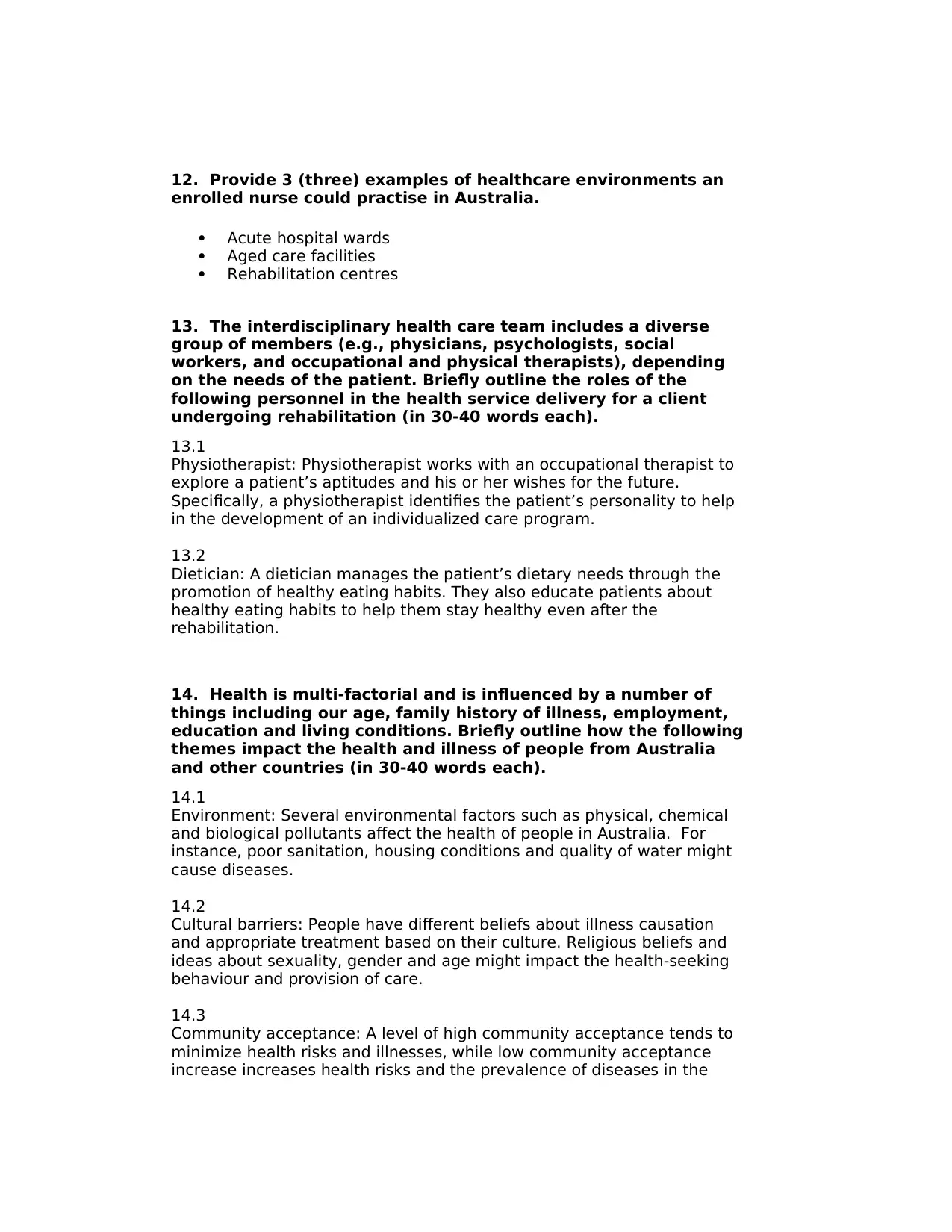
12. Provide 3 (three) examples of healthcare environments an
enrolled nurse could practise in Australia.
Acute hospital wards
Aged care facilities
Rehabilitation centres
13. The interdisciplinary health care team includes a diverse
group of members (e.g., physicians, psychologists, social
workers, and occupational and physical therapists), depending
on the needs of the patient. Briefly outline the roles of the
following personnel in the health service delivery for a client
undergoing rehabilitation (in 30-40 words each).
13.1
Physiotherapist: Physiotherapist works with an occupational therapist to
explore a patient’s aptitudes and his or her wishes for the future.
Specifically, a physiotherapist identifies the patient’s personality to help
in the development of an individualized care program.
13.2
Dietician: A dietician manages the patient’s dietary needs through the
promotion of healthy eating habits. They also educate patients about
healthy eating habits to help them stay healthy even after the
rehabilitation.
14. Health is multi-factorial and is influenced by a number of
things including our age, family history of illness, employment,
education and living conditions. Briefly outline how the following
themes impact the health and illness of people from Australia
and other countries (in 30-40 words each).
14.1
Environment: Several environmental factors such as physical, chemical
and biological pollutants affect the health of people in Australia. For
instance, poor sanitation, housing conditions and quality of water might
cause diseases.
14.2
Cultural barriers: People have different beliefs about illness causation
and appropriate treatment based on their culture. Religious beliefs and
ideas about sexuality, gender and age might impact the health-seeking
behaviour and provision of care.
14.3
Community acceptance: A level of high community acceptance tends to
minimize health risks and illnesses, while low community acceptance
increase increases health risks and the prevalence of diseases in the
enrolled nurse could practise in Australia.
Acute hospital wards
Aged care facilities
Rehabilitation centres
13. The interdisciplinary health care team includes a diverse
group of members (e.g., physicians, psychologists, social
workers, and occupational and physical therapists), depending
on the needs of the patient. Briefly outline the roles of the
following personnel in the health service delivery for a client
undergoing rehabilitation (in 30-40 words each).
13.1
Physiotherapist: Physiotherapist works with an occupational therapist to
explore a patient’s aptitudes and his or her wishes for the future.
Specifically, a physiotherapist identifies the patient’s personality to help
in the development of an individualized care program.
13.2
Dietician: A dietician manages the patient’s dietary needs through the
promotion of healthy eating habits. They also educate patients about
healthy eating habits to help them stay healthy even after the
rehabilitation.
14. Health is multi-factorial and is influenced by a number of
things including our age, family history of illness, employment,
education and living conditions. Briefly outline how the following
themes impact the health and illness of people from Australia
and other countries (in 30-40 words each).
14.1
Environment: Several environmental factors such as physical, chemical
and biological pollutants affect the health of people in Australia. For
instance, poor sanitation, housing conditions and quality of water might
cause diseases.
14.2
Cultural barriers: People have different beliefs about illness causation
and appropriate treatment based on their culture. Religious beliefs and
ideas about sexuality, gender and age might impact the health-seeking
behaviour and provision of care.
14.3
Community acceptance: A level of high community acceptance tends to
minimize health risks and illnesses, while low community acceptance
increase increases health risks and the prevalence of diseases in the
Paraphrase This Document
Need a fresh take? Get an instant paraphrase of this document with our AI Paraphraser
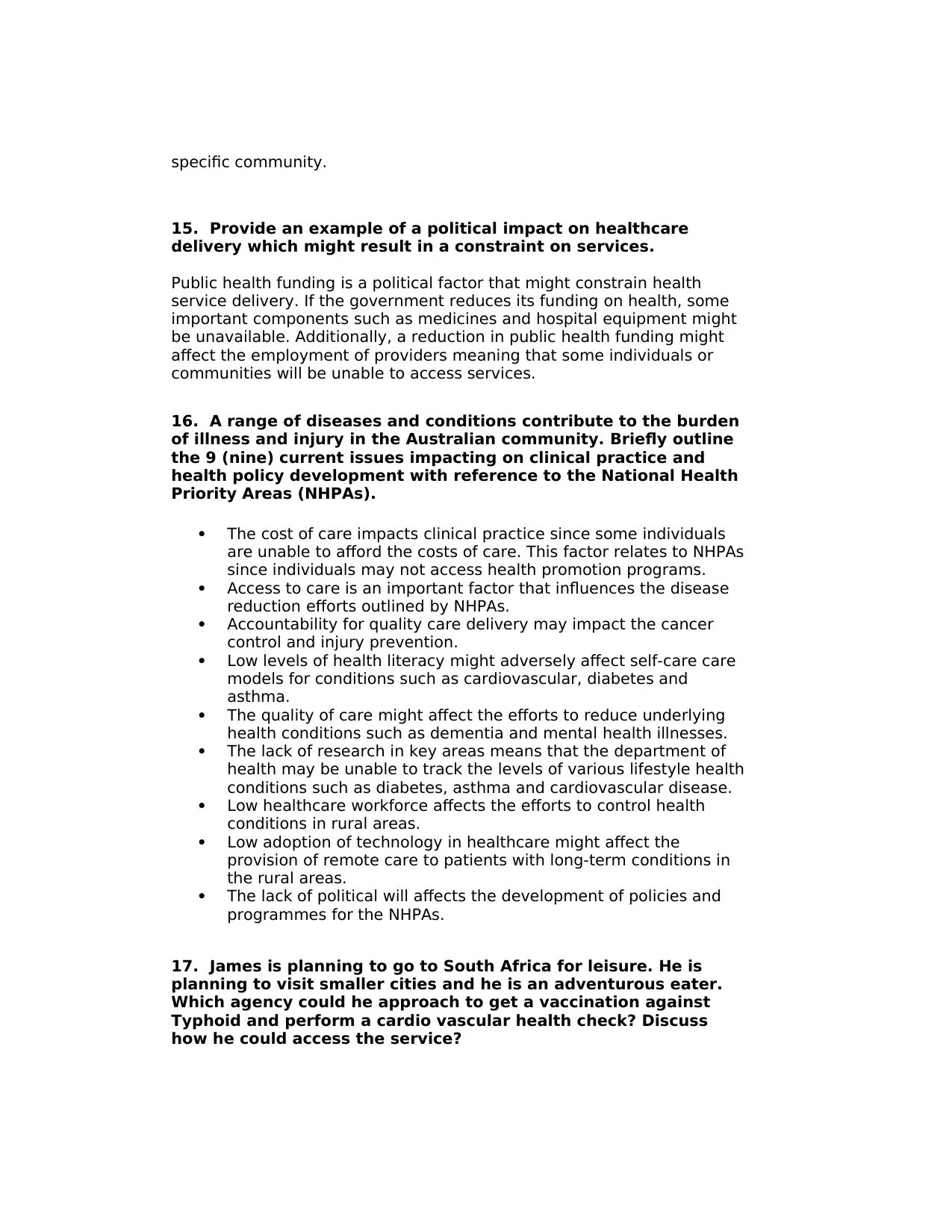
specific community.
15. Provide an example of a political impact on healthcare
delivery which might result in a constraint on services.
Public health funding is a political factor that might constrain health
service delivery. If the government reduces its funding on health, some
important components such as medicines and hospital equipment might
be unavailable. Additionally, a reduction in public health funding might
affect the employment of providers meaning that some individuals or
communities will be unable to access services.
16. A range of diseases and conditions contribute to the burden
of illness and injury in the Australian community. Briefly outline
the 9 (nine) current issues impacting on clinical practice and
health policy development with reference to the National Health
Priority Areas (NHPAs).
The cost of care impacts clinical practice since some individuals
are unable to afford the costs of care. This factor relates to NHPAs
since individuals may not access health promotion programs.
Access to care is an important factor that influences the disease
reduction efforts outlined by NHPAs.
Accountability for quality care delivery may impact the cancer
control and injury prevention.
Low levels of health literacy might adversely affect self-care care
models for conditions such as cardiovascular, diabetes and
asthma.
The quality of care might affect the efforts to reduce underlying
health conditions such as dementia and mental health illnesses.
The lack of research in key areas means that the department of
health may be unable to track the levels of various lifestyle health
conditions such as diabetes, asthma and cardiovascular disease.
Low healthcare workforce affects the efforts to control health
conditions in rural areas.
Low adoption of technology in healthcare might affect the
provision of remote care to patients with long-term conditions in
the rural areas.
The lack of political will affects the development of policies and
programmes for the NHPAs.
17. James is planning to go to South Africa for leisure. He is
planning to visit smaller cities and he is an adventurous eater.
Which agency could he approach to get a vaccination against
Typhoid and perform a cardio vascular health check? Discuss
how he could access the service?
15. Provide an example of a political impact on healthcare
delivery which might result in a constraint on services.
Public health funding is a political factor that might constrain health
service delivery. If the government reduces its funding on health, some
important components such as medicines and hospital equipment might
be unavailable. Additionally, a reduction in public health funding might
affect the employment of providers meaning that some individuals or
communities will be unable to access services.
16. A range of diseases and conditions contribute to the burden
of illness and injury in the Australian community. Briefly outline
the 9 (nine) current issues impacting on clinical practice and
health policy development with reference to the National Health
Priority Areas (NHPAs).
The cost of care impacts clinical practice since some individuals
are unable to afford the costs of care. This factor relates to NHPAs
since individuals may not access health promotion programs.
Access to care is an important factor that influences the disease
reduction efforts outlined by NHPAs.
Accountability for quality care delivery may impact the cancer
control and injury prevention.
Low levels of health literacy might adversely affect self-care care
models for conditions such as cardiovascular, diabetes and
asthma.
The quality of care might affect the efforts to reduce underlying
health conditions such as dementia and mental health illnesses.
The lack of research in key areas means that the department of
health may be unable to track the levels of various lifestyle health
conditions such as diabetes, asthma and cardiovascular disease.
Low healthcare workforce affects the efforts to control health
conditions in rural areas.
Low adoption of technology in healthcare might affect the
provision of remote care to patients with long-term conditions in
the rural areas.
The lack of political will affects the development of policies and
programmes for the NHPAs.
17. James is planning to go to South Africa for leisure. He is
planning to visit smaller cities and he is an adventurous eater.
Which agency could he approach to get a vaccination against
Typhoid and perform a cardio vascular health check? Discuss
how he could access the service?
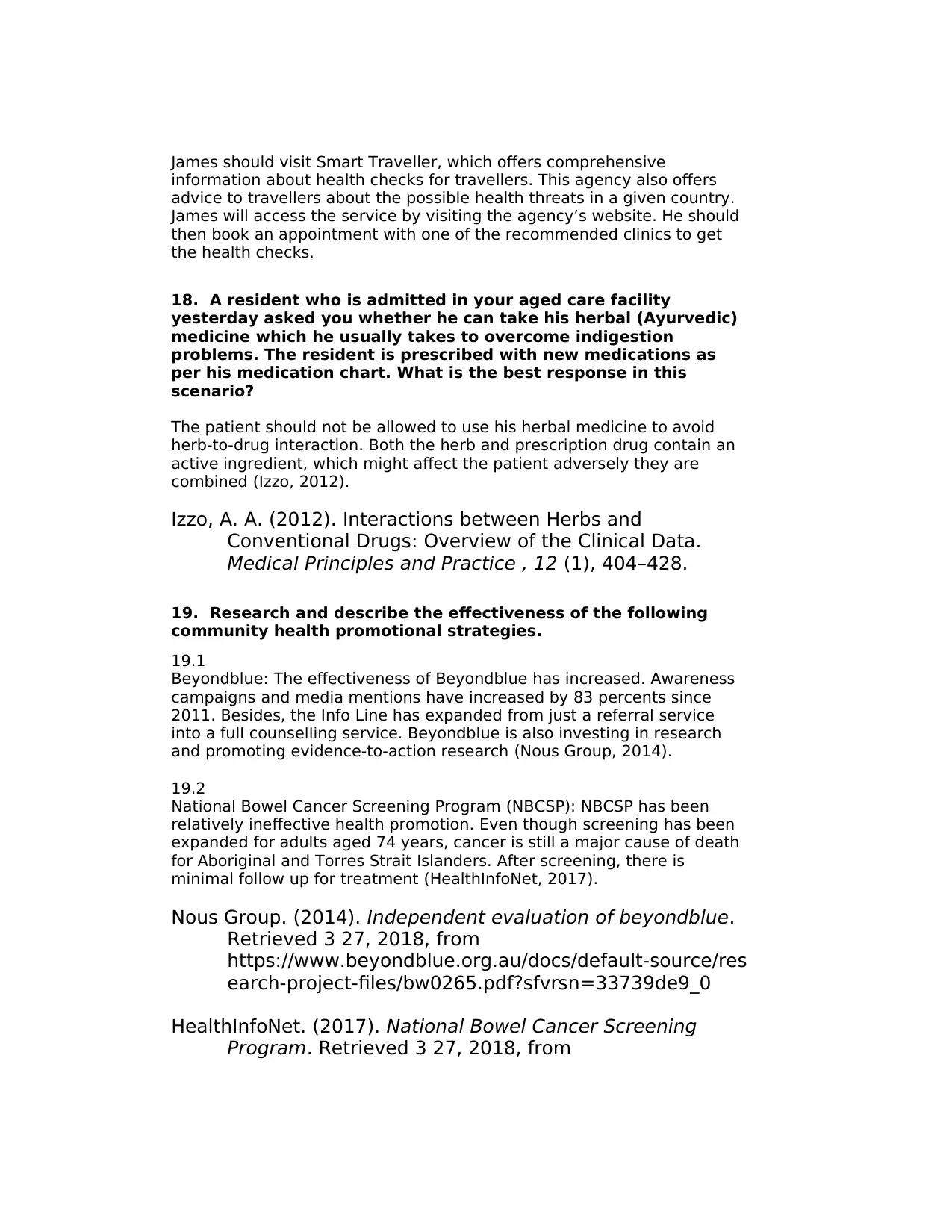
James should visit Smart Traveller, which offers comprehensive
information about health checks for travellers. This agency also offers
advice to travellers about the possible health threats in a given country.
James will access the service by visiting the agency’s website. He should
then book an appointment with one of the recommended clinics to get
the health checks.
18. A resident who is admitted in your aged care facility
yesterday asked you whether he can take his herbal (Ayurvedic)
medicine which he usually takes to overcome indigestion
problems. The resident is prescribed with new medications as
per his medication chart. What is the best response in this
scenario?
The patient should not be allowed to use his herbal medicine to avoid
herb-to-drug interaction. Both the herb and prescription drug contain an
active ingredient, which might affect the patient adversely they are
combined (Izzo, 2012).
Izzo, A. A. (2012). Interactions between Herbs and
Conventional Drugs: Overview of the Clinical Data.
Medical Principles and Practice , 12 (1), 404–428.
19. Research and describe the effectiveness of the following
community health promotional strategies.
19.1
Beyondblue: The effectiveness of Beyondblue has increased. Awareness
campaigns and media mentions have increased by 83 percents since
2011. Besides, the Info Line has expanded from just a referral service
into a full counselling service. Beyondblue is also investing in research
and promoting evidence-to-action research (Nous Group, 2014).
19.2
National Bowel Cancer Screening Program (NBCSP): NBCSP has been
relatively ineffective health promotion. Even though screening has been
expanded for adults aged 74 years, cancer is still a major cause of death
for Aboriginal and Torres Strait Islanders. After screening, there is
minimal follow up for treatment (HealthInfoNet, 2017).
Nous Group. (2014). Independent evaluation of beyondblue.
Retrieved 3 27, 2018, from
https://www.beyondblue.org.au/docs/default-source/res
earch-project-files/bw0265.pdf?sfvrsn=33739de9_0
HealthInfoNet. (2017). National Bowel Cancer Screening
Program. Retrieved 3 27, 2018, from
information about health checks for travellers. This agency also offers
advice to travellers about the possible health threats in a given country.
James will access the service by visiting the agency’s website. He should
then book an appointment with one of the recommended clinics to get
the health checks.
18. A resident who is admitted in your aged care facility
yesterday asked you whether he can take his herbal (Ayurvedic)
medicine which he usually takes to overcome indigestion
problems. The resident is prescribed with new medications as
per his medication chart. What is the best response in this
scenario?
The patient should not be allowed to use his herbal medicine to avoid
herb-to-drug interaction. Both the herb and prescription drug contain an
active ingredient, which might affect the patient adversely they are
combined (Izzo, 2012).
Izzo, A. A. (2012). Interactions between Herbs and
Conventional Drugs: Overview of the Clinical Data.
Medical Principles and Practice , 12 (1), 404–428.
19. Research and describe the effectiveness of the following
community health promotional strategies.
19.1
Beyondblue: The effectiveness of Beyondblue has increased. Awareness
campaigns and media mentions have increased by 83 percents since
2011. Besides, the Info Line has expanded from just a referral service
into a full counselling service. Beyondblue is also investing in research
and promoting evidence-to-action research (Nous Group, 2014).
19.2
National Bowel Cancer Screening Program (NBCSP): NBCSP has been
relatively ineffective health promotion. Even though screening has been
expanded for adults aged 74 years, cancer is still a major cause of death
for Aboriginal and Torres Strait Islanders. After screening, there is
minimal follow up for treatment (HealthInfoNet, 2017).
Nous Group. (2014). Independent evaluation of beyondblue.
Retrieved 3 27, 2018, from
https://www.beyondblue.org.au/docs/default-source/res
earch-project-files/bw0265.pdf?sfvrsn=33739de9_0
HealthInfoNet. (2017). National Bowel Cancer Screening
Program. Retrieved 3 27, 2018, from
⊘ This is a preview!⊘
Do you want full access?
Subscribe today to unlock all pages.

Trusted by 1+ million students worldwide
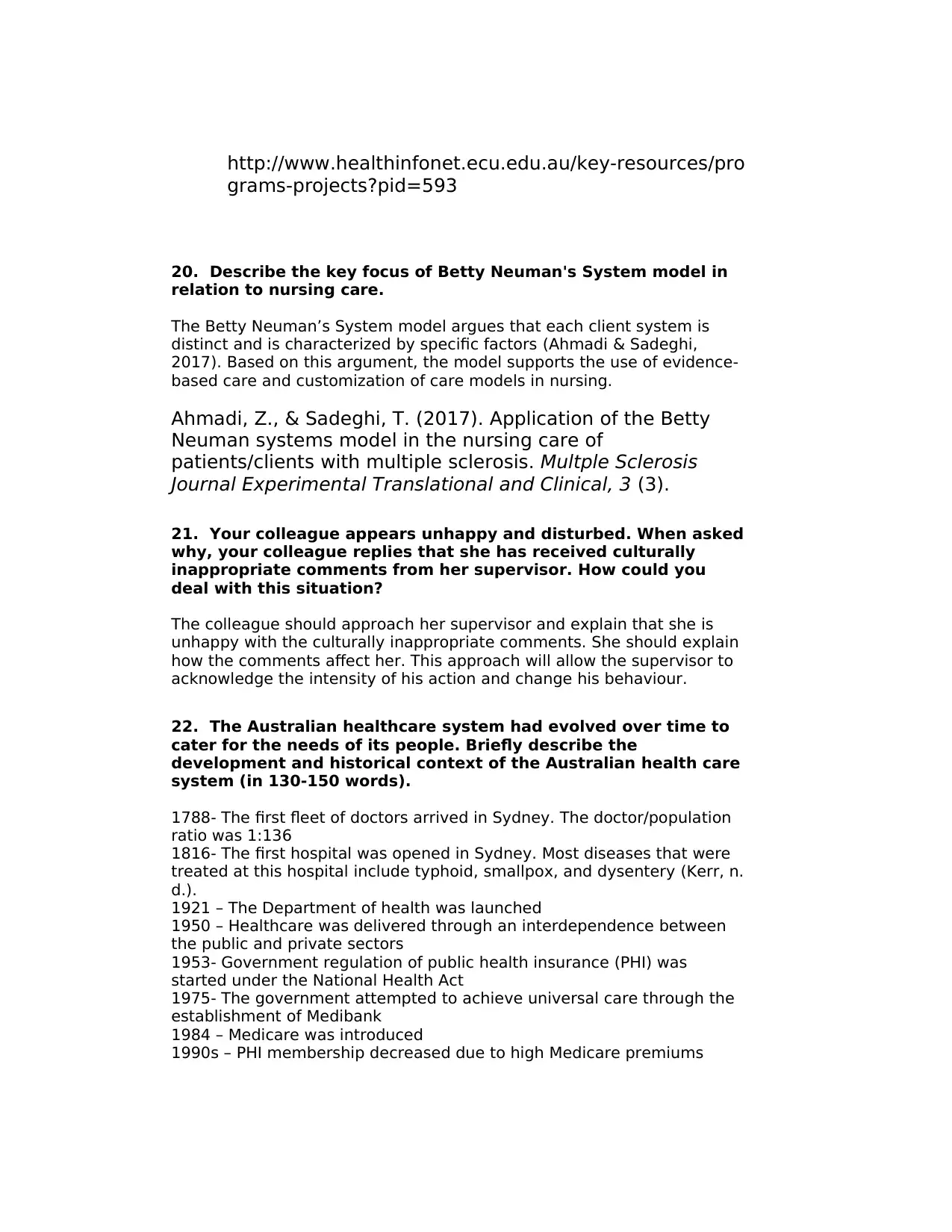
http://www.healthinfonet.ecu.edu.au/key-resources/pro
grams-projects?pid=593
20. Describe the key focus of Betty Neuman's System model in
relation to nursing care.
The Betty Neuman’s System model argues that each client system is
distinct and is characterized by specific factors (Ahmadi & Sadeghi,
2017). Based on this argument, the model supports the use of evidence-
based care and customization of care models in nursing.
Ahmadi, Z., & Sadeghi, T. (2017). Application of the Betty
Neuman systems model in the nursing care of
patients/clients with multiple sclerosis. Multple Sclerosis
Journal Experimental Translational and Clinical, 3 (3).
21. Your colleague appears unhappy and disturbed. When asked
why, your colleague replies that she has received culturally
inappropriate comments from her supervisor. How could you
deal with this situation?
The colleague should approach her supervisor and explain that she is
unhappy with the culturally inappropriate comments. She should explain
how the comments affect her. This approach will allow the supervisor to
acknowledge the intensity of his action and change his behaviour.
22. The Australian healthcare system had evolved over time to
cater for the needs of its people. Briefly describe the
development and historical context of the Australian health care
system (in 130-150 words).
1788- The first fleet of doctors arrived in Sydney. The doctor/population
ratio was 1:136
1816- The first hospital was opened in Sydney. Most diseases that were
treated at this hospital include typhoid, smallpox, and dysentery (Kerr, n.
d.).
1921 – The Department of health was launched
1950 – Healthcare was delivered through an interdependence between
the public and private sectors
1953- Government regulation of public health insurance (PHI) was
started under the National Health Act
1975- The government attempted to achieve universal care through the
establishment of Medibank
1984 – Medicare was introduced
1990s – PHI membership decreased due to high Medicare premiums
grams-projects?pid=593
20. Describe the key focus of Betty Neuman's System model in
relation to nursing care.
The Betty Neuman’s System model argues that each client system is
distinct and is characterized by specific factors (Ahmadi & Sadeghi,
2017). Based on this argument, the model supports the use of evidence-
based care and customization of care models in nursing.
Ahmadi, Z., & Sadeghi, T. (2017). Application of the Betty
Neuman systems model in the nursing care of
patients/clients with multiple sclerosis. Multple Sclerosis
Journal Experimental Translational and Clinical, 3 (3).
21. Your colleague appears unhappy and disturbed. When asked
why, your colleague replies that she has received culturally
inappropriate comments from her supervisor. How could you
deal with this situation?
The colleague should approach her supervisor and explain that she is
unhappy with the culturally inappropriate comments. She should explain
how the comments affect her. This approach will allow the supervisor to
acknowledge the intensity of his action and change his behaviour.
22. The Australian healthcare system had evolved over time to
cater for the needs of its people. Briefly describe the
development and historical context of the Australian health care
system (in 130-150 words).
1788- The first fleet of doctors arrived in Sydney. The doctor/population
ratio was 1:136
1816- The first hospital was opened in Sydney. Most diseases that were
treated at this hospital include typhoid, smallpox, and dysentery (Kerr, n.
d.).
1921 – The Department of health was launched
1950 – Healthcare was delivered through an interdependence between
the public and private sectors
1953- Government regulation of public health insurance (PHI) was
started under the National Health Act
1975- The government attempted to achieve universal care through the
establishment of Medibank
1984 – Medicare was introduced
1990s – PHI membership decreased due to high Medicare premiums
Paraphrase This Document
Need a fresh take? Get an instant paraphrase of this document with our AI Paraphraser
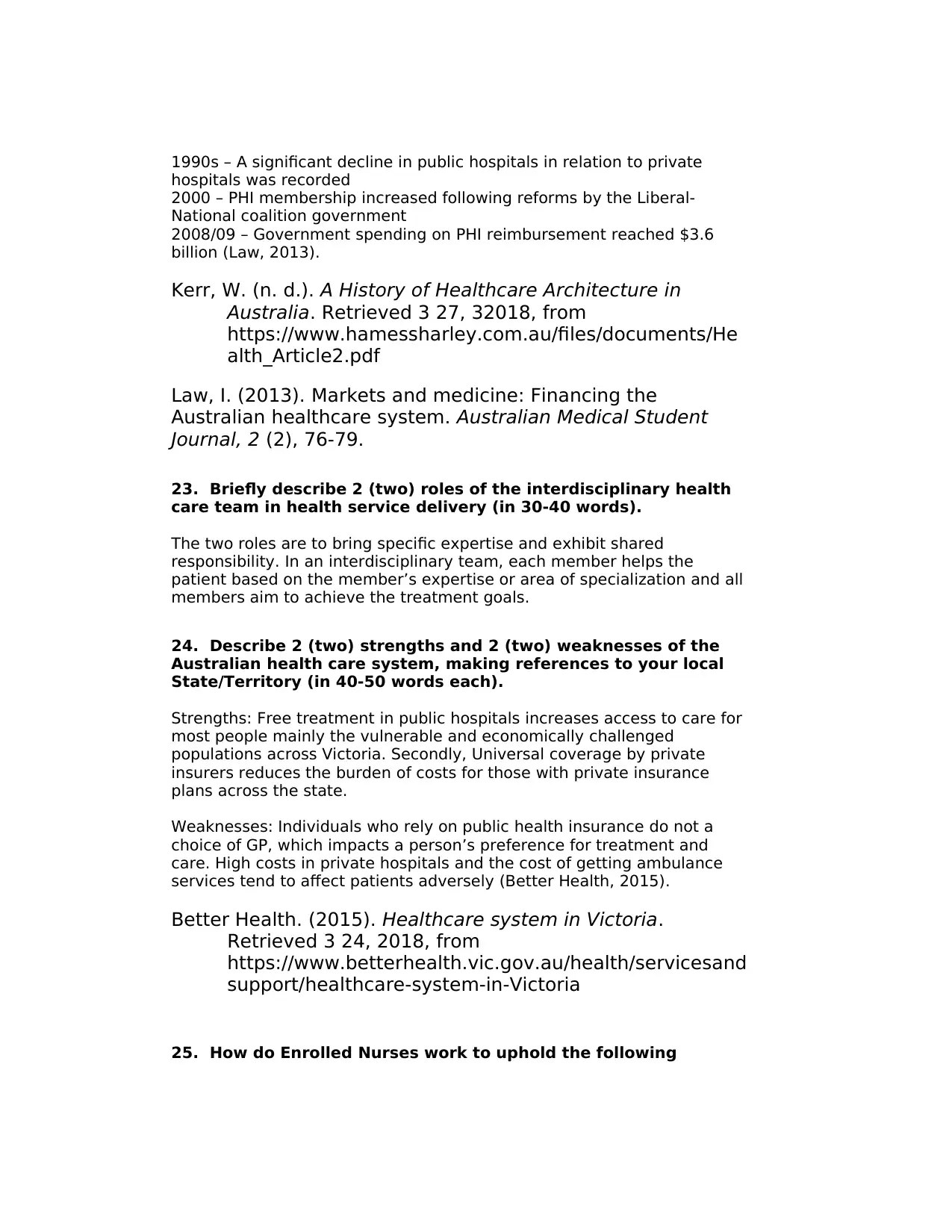
1990s – A significant decline in public hospitals in relation to private
hospitals was recorded
2000 – PHI membership increased following reforms by the Liberal-
National coalition government
2008/09 – Government spending on PHI reimbursement reached $3.6
billion (Law, 2013).
Kerr, W. (n. d.). A History of Healthcare Architecture in
Australia. Retrieved 3 27, 32018, from
https://www.hamessharley.com.au/files/documents/He
alth_Article2.pdf
Law, I. (2013). Markets and medicine: Financing the
Australian healthcare system. Australian Medical Student
Journal, 2 (2), 76-79.
23. Briefly describe 2 (two) roles of the interdisciplinary health
care team in health service delivery (in 30-40 words).
The two roles are to bring specific expertise and exhibit shared
responsibility. In an interdisciplinary team, each member helps the
patient based on the member’s expertise or area of specialization and all
members aim to achieve the treatment goals.
24. Describe 2 (two) strengths and 2 (two) weaknesses of the
Australian health care system, making references to your local
State/Territory (in 40-50 words each).
Strengths: Free treatment in public hospitals increases access to care for
most people mainly the vulnerable and economically challenged
populations across Victoria. Secondly, Universal coverage by private
insurers reduces the burden of costs for those with private insurance
plans across the state.
Weaknesses: Individuals who rely on public health insurance do not a
choice of GP, which impacts a person’s preference for treatment and
care. High costs in private hospitals and the cost of getting ambulance
services tend to affect patients adversely (Better Health, 2015).
Better Health. (2015). Healthcare system in Victoria.
Retrieved 3 24, 2018, from
https://www.betterhealth.vic.gov.au/health/servicesand
support/healthcare-system-in-Victoria
25. How do Enrolled Nurses work to uphold the following
hospitals was recorded
2000 – PHI membership increased following reforms by the Liberal-
National coalition government
2008/09 – Government spending on PHI reimbursement reached $3.6
billion (Law, 2013).
Kerr, W. (n. d.). A History of Healthcare Architecture in
Australia. Retrieved 3 27, 32018, from
https://www.hamessharley.com.au/files/documents/He
alth_Article2.pdf
Law, I. (2013). Markets and medicine: Financing the
Australian healthcare system. Australian Medical Student
Journal, 2 (2), 76-79.
23. Briefly describe 2 (two) roles of the interdisciplinary health
care team in health service delivery (in 30-40 words).
The two roles are to bring specific expertise and exhibit shared
responsibility. In an interdisciplinary team, each member helps the
patient based on the member’s expertise or area of specialization and all
members aim to achieve the treatment goals.
24. Describe 2 (two) strengths and 2 (two) weaknesses of the
Australian health care system, making references to your local
State/Territory (in 40-50 words each).
Strengths: Free treatment in public hospitals increases access to care for
most people mainly the vulnerable and economically challenged
populations across Victoria. Secondly, Universal coverage by private
insurers reduces the burden of costs for those with private insurance
plans across the state.
Weaknesses: Individuals who rely on public health insurance do not a
choice of GP, which impacts a person’s preference for treatment and
care. High costs in private hospitals and the cost of getting ambulance
services tend to affect patients adversely (Better Health, 2015).
Better Health. (2015). Healthcare system in Victoria.
Retrieved 3 24, 2018, from
https://www.betterhealth.vic.gov.au/health/servicesand
support/healthcare-system-in-Victoria
25. How do Enrolled Nurses work to uphold the following
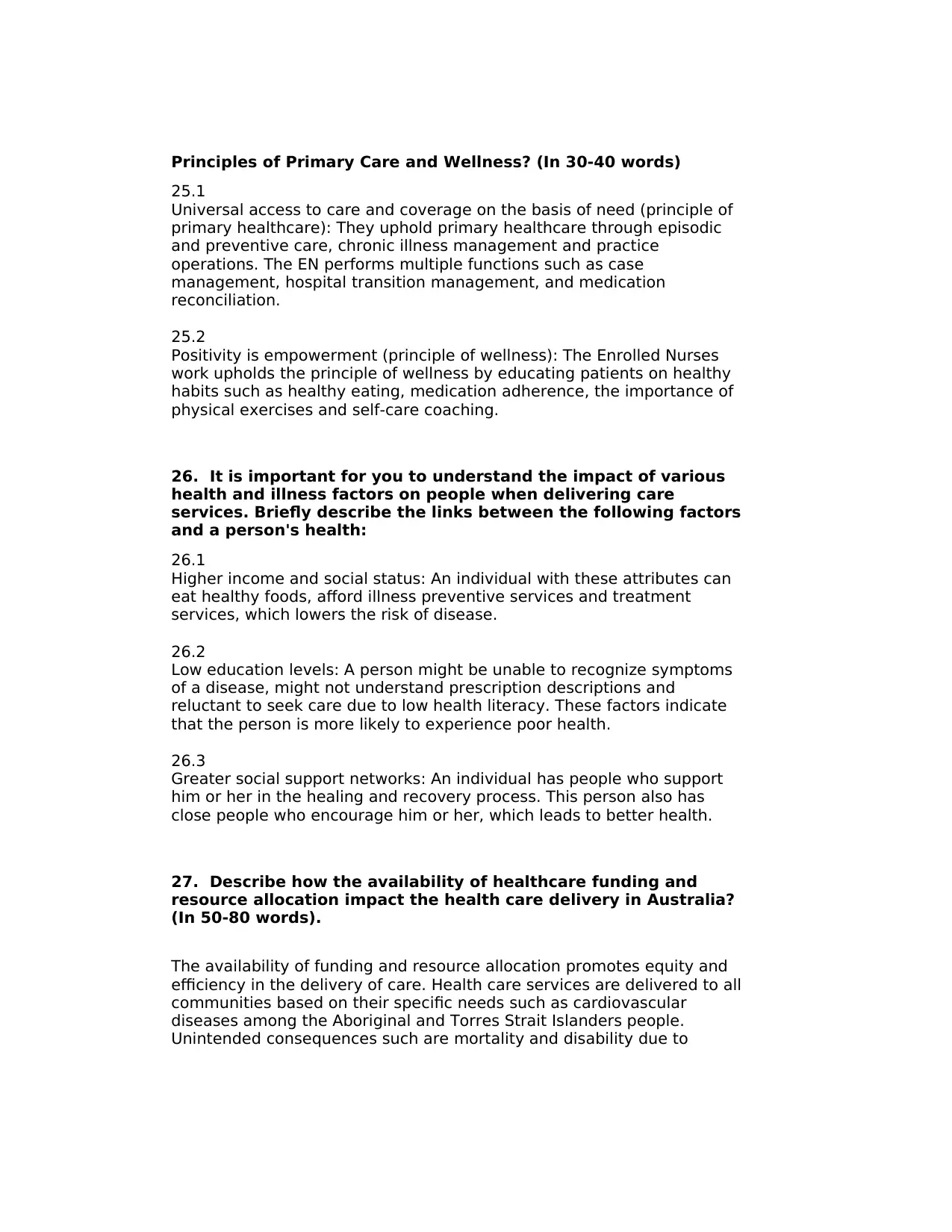
Principles of Primary Care and Wellness? (In 30-40 words)
25.1
Universal access to care and coverage on the basis of need (principle of
primary healthcare): They uphold primary healthcare through episodic
and preventive care, chronic illness management and practice
operations. The EN performs multiple functions such as case
management, hospital transition management, and medication
reconciliation.
25.2
Positivity is empowerment (principle of wellness): The Enrolled Nurses
work upholds the principle of wellness by educating patients on healthy
habits such as healthy eating, medication adherence, the importance of
physical exercises and self-care coaching.
26. It is important for you to understand the impact of various
health and illness factors on people when delivering care
services. Briefly describe the links between the following factors
and a person's health:
26.1
Higher income and social status: An individual with these attributes can
eat healthy foods, afford illness preventive services and treatment
services, which lowers the risk of disease.
26.2
Low education levels: A person might be unable to recognize symptoms
of a disease, might not understand prescription descriptions and
reluctant to seek care due to low health literacy. These factors indicate
that the person is more likely to experience poor health.
26.3
Greater social support networks: An individual has people who support
him or her in the healing and recovery process. This person also has
close people who encourage him or her, which leads to better health.
27. Describe how the availability of healthcare funding and
resource allocation impact the health care delivery in Australia?
(In 50-80 words).
The availability of funding and resource allocation promotes equity and
efficiency in the delivery of care. Health care services are delivered to all
communities based on their specific needs such as cardiovascular
diseases among the Aboriginal and Torres Strait Islanders people.
Unintended consequences such are mortality and disability due to
25.1
Universal access to care and coverage on the basis of need (principle of
primary healthcare): They uphold primary healthcare through episodic
and preventive care, chronic illness management and practice
operations. The EN performs multiple functions such as case
management, hospital transition management, and medication
reconciliation.
25.2
Positivity is empowerment (principle of wellness): The Enrolled Nurses
work upholds the principle of wellness by educating patients on healthy
habits such as healthy eating, medication adherence, the importance of
physical exercises and self-care coaching.
26. It is important for you to understand the impact of various
health and illness factors on people when delivering care
services. Briefly describe the links between the following factors
and a person's health:
26.1
Higher income and social status: An individual with these attributes can
eat healthy foods, afford illness preventive services and treatment
services, which lowers the risk of disease.
26.2
Low education levels: A person might be unable to recognize symptoms
of a disease, might not understand prescription descriptions and
reluctant to seek care due to low health literacy. These factors indicate
that the person is more likely to experience poor health.
26.3
Greater social support networks: An individual has people who support
him or her in the healing and recovery process. This person also has
close people who encourage him or her, which leads to better health.
27. Describe how the availability of healthcare funding and
resource allocation impact the health care delivery in Australia?
(In 50-80 words).
The availability of funding and resource allocation promotes equity and
efficiency in the delivery of care. Health care services are delivered to all
communities based on their specific needs such as cardiovascular
diseases among the Aboriginal and Torres Strait Islanders people.
Unintended consequences such are mortality and disability due to
⊘ This is a preview!⊘
Do you want full access?
Subscribe today to unlock all pages.

Trusted by 1+ million students worldwide
1 out of 13
Related Documents
Your All-in-One AI-Powered Toolkit for Academic Success.
+13062052269
info@desklib.com
Available 24*7 on WhatsApp / Email
![[object Object]](/_next/static/media/star-bottom.7253800d.svg)
Unlock your academic potential
Copyright © 2020–2025 A2Z Services. All Rights Reserved. Developed and managed by ZUCOL.





